QE2, An Invitation to an Inflation Party?
Economics / Quantitative Easing Sep 26, 2010 - 04:21 AM GMTBy: John_Mauldin
 This week the Fed altered their end-of-meeting statement by just a few words, but those words have a lot of meaning. It seems they are paving the way to a new round of quantitative easing (QE2), if in their opinion the situation warrants it. A trillion dollars of new money could soon be injected into the system. Tonight we explore some of the implications of a new round of QE. Let's put our speculation hats on, gentle reader, as we are moving into uncharted territory. There are no maps, just theories, and they don't all agree. (Note: this letter may print a little long, as there are a lot of charts.)
This week the Fed altered their end-of-meeting statement by just a few words, but those words have a lot of meaning. It seems they are paving the way to a new round of quantitative easing (QE2), if in their opinion the situation warrants it. A trillion dollars of new money could soon be injected into the system. Tonight we explore some of the implications of a new round of QE. Let's put our speculation hats on, gentle reader, as we are moving into uncharted territory. There are no maps, just theories, and they don't all agree. (Note: this letter may print a little long, as there are a lot of charts.)
But first, as a reminder, next Wednesday, September 29 (9:00 AM PST/12:00 PM EST), I will be doing a special "webinar" with Jon Sundt, President & CEO of Altegris Investments, where we'll discuss the forces that are shaping today's economy and their potential influence on financial markets (the very things I write about in this week's letter and in my new book!). This is an excellent opportunity to learn about alternative investment strategies designed to provide noncorrelated diversification for your investment portfolio in the "new normal" economy. We'll set aside a lot of time to answer your questions.
A replay of the call will be available for two weeks starting Thursday, September 30, for registered participants only. Even if you can't make it at this specific time, I recommend you still register so you can listen to the replay at your convenience after the event.
You can register by going to www.accreditedinvestor.ws and signing up for my free accredited letter, and a representative from Altegris will call you to give you the details. Sadly, this is available only to accredited investors ($1.5 million net worth and up) and/or registered financial professionals, due to current regulations. I will be giving a preview of the conclusions from my new book, The End Game, which I think you will find interesting. (In this regard, I am president and a registered representative of Millennium Wave Securities, LLC, member FINRA.)
Let's Shift the Focus
The Fed issued the usual statement at the end of their meeting this week, and Fed watchers poured over the words, looking carefully for any sign of change in Fed policy. The consensus seems to be that the most important change was the statement concerning inflation, the first such change in over a year.
"Measures of inflation are currently at levels somewhat below those the Committee judges most consistent, over the longer run, with its mandate to promote maximum employment and price stability."
The next (and only other real) change was:
"The Committee will continue to monitor the economic outlook and financial developments and is prepared to provide additional accommodation if needed to support the economic recovery and to return inflation, over time, to levels consistent with its mandate." (my emphasis)
Translation: inflation may be getting too low, but don't worry, we are on the job.
One of my laugh lines in my speeches (I don't have that many) is: "When you are appointed to the Federal Reserve they take you into a back room and do a DNA change on you. After that, you are viscerally and genetically opposed to deflation."
Bernanke made his famous helicopter speech about not allowing deflation to happen back in 2002. He happily assured us that the Fed has many tools to fight deflation and that it won't happen here. Of course, he also told us the subprime problem would be contained, but I am sure that we have to give him a bit of slack - we all miss a few, including your humble analyst. (Well, I didn't miss the subprime thingie. Nailed that one.)
Anyway, the Fed seems to be setting us up for another round of quantitative easing. That is Fed speak for buying a few trillion or so dollars of government debt and injecting said cash into the economy.
Before we get into the wisdom of such a move, let's look at what might prompt them to do so. This is where we get into speculation.
Recessions are by definition deflationary, but if we go into recession when inflation is already as low as it is, the Fed will be behind the curve. But telling us they are going to start easing because they are worried about a recession is not a good recipe for a positive market reaction.
So? Why not just say that they are worried about the lack of inflation, "at levels somewhat below those the Committee judges most consistent, over the longer run, with its mandate to promote maximum employment and price stability." That way they are not fighting a weak economy but rather something that everyone understands, i.e., deflation.
I agree with David Greenlaw from Morgan Stanley. He writes:
"Growth data still take precedence. The change in the inflation language, while important, does not, in our view, signal an elevated emphasis on the incoming inflation data itself as a possible trigger for asset purchases. To be sure, the inflation data do matter, but the growth indicators matter more because, from the Fed's perspective, the pace of growth in economic activity is a leading indicator of inflation. Here is a key excerpt from Bernanke's Jackson Hole speech that helps explain the perceived link between growth and inflation:
"'...the FOMC will do all that it can to ensure continuation of the economic recovery. Consistent with our mandate, the Federal Reserve is committed to promoting growth in employment and reducing resource slack more generally. Because a further significant weakening in the economic outlook would likely be associated with further disinflation, in the current environment there is little or no potential conflict between the goals of supporting growth and employment and of maintaining price stability.'" (emphasis added)
The key driver for whether the Fed enters into another round of quantitative easing, likely to be in the trillions, is the growth in the US economy. If we are above 1.5-2%, I think they will hesitate, for reasons I go into below. If we drop below 1% and it looks like we are getting weaker, then they are likely to act. A slide into recession would bring about deflation. As noted, they are viscerally opposed to deflation.
An Invitation to an Inflation Party
The question in my mind is whether a few trillion dollars spent purchasing government debt would do the trick. What if they sent out invitations to an inflation party and nobody came? Let's look at some data points.
The Fed purchased $1.25 trillion in mortgage assets last year. The theory was that injecting money into the economy would cause banks to take that money and lend it, jump-starting the economy and bringing us back into a normal recovery. Let's see how the lending part went. Here are a few graphs from the St. Louis Fed FRED database.
The first is "Bank Credit of All Commercial Banks." Please note that the straight upward line in the middle of 2010 is an accounting change. Without that the trend would still be down.
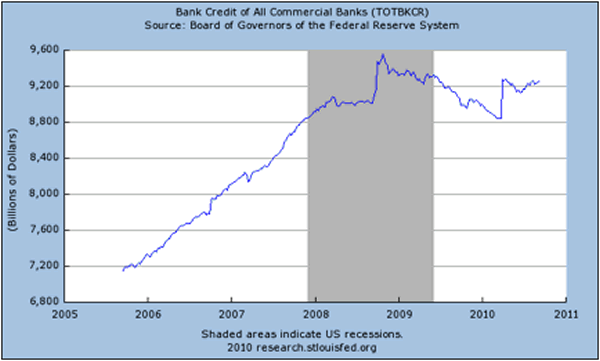
Then we have "Total Consumer Credit Outstanding." That had been growing steadily for 65 years until this last recession.
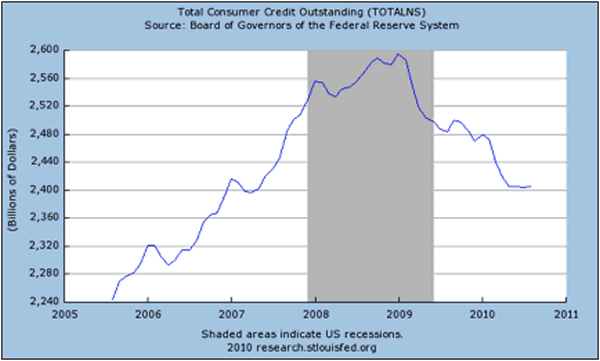
Next we have "Commercial and Industrial Loans at All Commercial Banks."
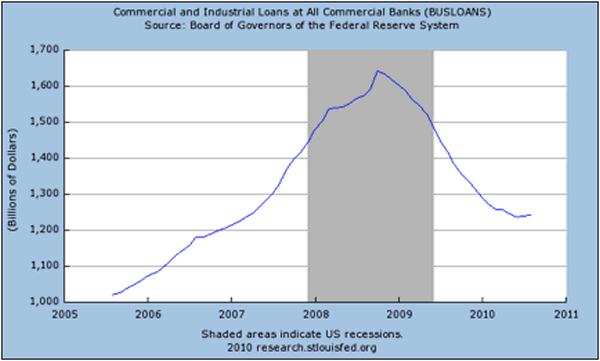
We could look at total residential mortgages (down); credit card debt (down); and commercial mortgages (down). The list goes on.
Sidebar from Greg Weldon:
"Also, the value of Commercial Property Loans classified as Special Servicing (restructured and-or- extended) rose to a NEW HIGH, pegged at 11.74% of all CMBS, as evidenced in the chart below."
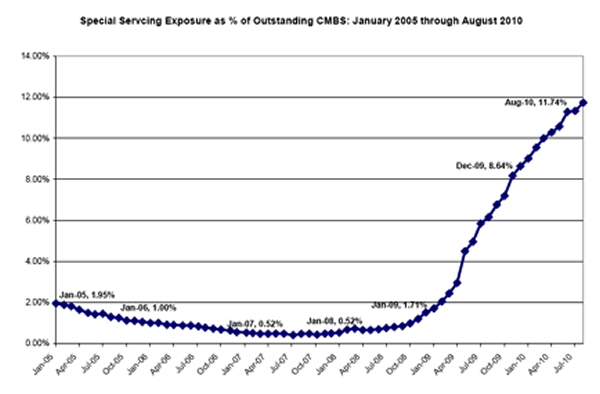
No wonder commercial mortgages are down.
So, what happened to the trillion-plus dollars? It doesn't look like it went into bank lending. As it turns out, it went back onto the balance sheet of the Federal Reserve. Banks put it back into the Fed. There are several ways you can measure this with the FRED database, but one way is to look at "Reserve Balances with Federal Reserve Banks, Not Adjusted for Changes in Reserve Requirements."
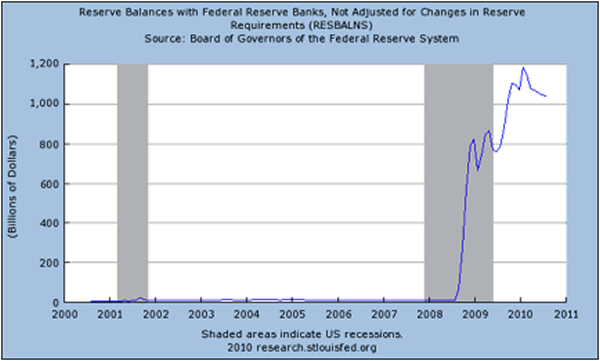
If banks are not lending now, with what seems like lots of reserves, then what is to make us think that another $2 trillion in QE will make them feel like they have too much money in their vaults?
If it is because they don't have enough capital, then adding liquidity to the system will not help that. If it is because they don't feel they have creditworthy customers, do we really want banks to lower their standards? Isn't that what got us into trouble last time? If it is because businesses don't want to borrow all that much because of the uncertain times, will easy money make that any better? As someone said, "I don't need more credit, I just need more customers."
How much of an impact would $2 trillion in QE give us? Not much, according to former Fed governor Larry Meyer, who, according to Morgan Stanley, "...maintains a large-scale macro-econometric model of the US economy that is widely used in the private sector and in public policy-making circles. These types of models are good for running 'what if?' simulations. Meyer estimates that a $2 trillion asset purchase program would: 1) lower Treasury yields by 50bp; 2) increase GDP growth by 0.3pp in 2011 and 0.4pp in 2012; and 3) lower the unemployment rate by 0.3pp by the end of 2011 and 0.5pp by the end of 2012. However, Meyer admits that these may be 'high-end estimates'.
"Some probability of a resumption of asset purchases is already priced in, and thus a full 50bp response in Treasuries is unlikely. Moreover, a model such as Meyer's is based on normal historical relationships and therefore assumes that the typical transmission mechanisms are working. For example, a drop in Treasury yields would lower borrowing costs for consumers and businesses, helping to stimulate consumption, business investment and housing. But there is good reason to believe that the transmission mechanism is at least partially broken at present, and thus the pass-through benefit to the economy associated with a small decline in Treasury yields (relative to current levels) would likely be infinitesimal." (Morgan Stanley)
That is not much bang for the buck, so to speak, but it would be pointing a gun with a very big bang at the valuation of the dollar. If QE were attempted on that scale, it would not be good for the dollar. My call for the pound and the euro to go to parity with the dollar would be out the window for some time, and maybe for good.
Now, if the strategy is to lower the dollar, then QE might make some sense; but of course no one would admit to that, not when we are accusing other countries of manipulating their currencies (as in China). No, we would just be fighting deflation. The fact that the dollar dropped would just be a coincidence, a necessary but sad thing in the important fight against deflation. (Please note tongue firmly in cheek. Not you, of course, but some other readers sometimes miss my sarcasm.)
Of course, not all agree that a lower dollar would necessarily be a bad thing. Ambrose Evans-Pritchard, writing in the London Telegraph, concludes a column in where he notes that there is a lot of opposition to QE2 from some fairly significant economic luminaries, and that:
"Dr Bernanke said in November 2002 that Japan had the economic instruments to pull itself out of malaise but failed to do so. 'Political deadlock' and a cacophony of views over the right policy had prevented action. He insisted that a central bank had 'most definitely' not run out of ammo once rates were zero, and retained 'considerable power to expand economic activity'.
"Yet eight years later, the US is in such 'deadlock'. Worse, Fed officials now say 'the ball is in the fiscal court', arguing that budget policy should do more to 'complement' the Fed's existing stimulus. Oh no!
"This is the worst possible prescription. What is needed is fiscal austerity (slowly) before debt spirals out of control, offset by easy money or real QE for as long as it takes. This formula rescued Britain from disaster in 1931-1933 and 1992-1994.
"Damn the rest of the world if they object. They have been free-loading off US demand for too long. A weaker dollar will force the mercantilists to face some hard truths. So keep those helicopters well-oiled and on standby."
Hmmmm. If everyone else wants to devalue their currency, should we play along? Can you say buy some more gold?
But back to the inflation party invitation. If the economy is recovering, QE is not needed. Note that the US economy in the current quarter may be doing better than last. And if you looked at the bank lending charts I presented above, an optimist could note that it looks like we might be seeing a bottom forming and even some increase in lending. Perhaps we have turned the corner. Again, the banks have plenty of reserves, so another $2 trillion is not needed.
But what if they went ahead and threw $1-2 trillion against the wall? If it showed up back at the Federal Reserve, it would only serve to show that the Fed does not have the tools it needs, or would have to be really willing to monetize debt. It would be Keynes' "liquidity trap" or what Fisher called debt deflation. Neither are good.
That's called pushing on a string. If the markets sensed that, it would not be pretty.
The Fed has been buying government debt for several months, taking the money from the mortgages that are being amortized and buying the debt. Let's maybe see how that works out before we bring out the big guns. Just a thought.
I agree with Allan Meltzer, a historian of the US central bank:
" 'We don't have a monetary problem, we have 1 trillion or more in excess reserves, so it's literally stupid to say we're going to add another trillion to that,' Meltzer, a professor at Carnegie Mellon University in Pittsburgh, said today in an interview on Bloomberg Television's 'InBusiness With Margaret Brennan.'
" 'One of the major mistakes that the Fed makes all the time is too much concentration on the short-term,' said Meltzer, author of a history of the Fed. 'Aiming at that is just a fool's game.' " (Business Week)
That being said, we live in a world where we need to act in terms of what will be rather than what should be. And if the economy continues to weaken, I think it is likely the Fed will act preemptively and start QE2. So the next few months of economic data are very important.
And even more important is whether Congress will extend the Bush tax cuts at least until the economy is growing respectably, when they come back for the lame duck session in November. Not extending them would be a policy mistake bigger than QE2, and might force even more precipitous action. We do live in interesting times.
Ten Years and Counting
Ten years ago I started this letter online with about 2,000 email addresses. Now the letter goes to over 1.5 million of my closest friends and is still growing. It is on dozens of web sites and is quoted everywhere. I have to admit to be somewhat overwhelmed by it all. I had literally no idea when I put that first letter on the Internet that it would become what it has. Of course, I made the lucky decision back then to make it free, when there were not that many free letters, so people sent it to their friends, who subscribed.
Every letter since the beginning of 2001 is in our archives. Good, bad, or indifferent, they are all there, just as they were sent out. I sometimes wish I could edit a few sentences here or there (what was I thinking?!?!?), but we made the decision early on to just let the chips fall where they may.
It wasn't long after that that Tiffani came to work for me (temporarily, we thought). She literally started in a closet, filing and doing data entry. Now she runs the businesses and Dad just reads and writes and does a little traveling and speaking, and from time to time finds a few new opportunities for her to add to her growing list.
And I have to mention my business partners around the world who have helped me create a dream job that gives me a comfortable lifestyle while having more fun than any one man should have. Jon Sundt and the team at Altegris, Steven Blumenthal at CMG, Niels Jensen and his team at Absolute Return Partners, Prieur du Plessis (and Paul Stewart) in South Africa, Enrique Fynn in South America, and John Nicola in Canada. Thanks so much. And of course this whole letter would not be possible without my great friend and publisher Mike Casson.
The last ten years have been a great ride, but the next ten are going to be even better. We will be launching several new web sites in the next few weeks, and reworking our old ones with total makeovers. There will be a forum where you can respond to this letter and talk with each other. I will respond to questions. We will soon be introducing audio podcasts ("The Mauldin Minute") and, when I get the concept down, go to video. Some new subscription services, too. And a much easier and better way to find alternative investments that have the potential to work for you in this crazy economic environment. We are excited.
But the letter will stay the same. It is just you, me, and a few other of my closest friends sharing a few thoughts every weekend. At the end of the day, it is you, gentle reader, who is the reason for the growth of this letter. Your kind words and persistence in forwarding to your friends have been the reason for whatever success there has been. I am grateful and humbled.
There is not a week that goes by that I do not acknowledge my great debt to you. My most sincere thanks. I will do my best to continue to deserve your valuable time that we share each week.
And now it is time to hit the send button. Eight cities in seven countries in nine days (ten planes!) have left me a little tired. I think I will rest a great deal this weekend, although I will spend some time editing my book. We are getting close. I am ready to be finished, but it has to be right. Have a great week.
Your ready to be in his own bed for a week analyst,
John F. Mauldin
johnmauldin@investorsinsight.com
John Mauldin, Best-Selling author and recognized financial expert, is also editor of the free Thoughts From the Frontline that goes to over 1 million readers each week. For more information on John or his FREE weekly economic letter go to: http://www.frontlinethoughts.com/learnmore
To subscribe to John Mauldin's E-Letter please click here:http://www.frontlinethoughts.com/subscribe.asp
Copyright 2010 John Mauldin. All Rights Reserved
Note: John Mauldin is the President of Millennium Wave Advisors, LLC (MWA), which is an investment advisory firm registered with multiple states. John Mauldin is a registered representative of Millennium Wave Securities, LLC, (MWS), an FINRA registered broker-dealer. MWS is also a Commodity Pool Operator (CPO) and a Commodity Trading Advisor (CTA) registered with the CFTC, as well as an Introducing Broker (IB). Millennium Wave Investments is a dba of MWA LLC and MWS LLC. Millennium Wave Investments cooperates in the consulting on and marketing of private investment offerings with other independent firms such as Altegris Investments; Absolute Return Partners, LLP; Plexus Asset Management; Fynn Capital; and Nicola Wealth Management. Funds recommended by Mauldin may pay a portion of their fees to these independent firms, who will share 1/3 of those fees with MWS and thus with Mauldin. Any views expressed herein are provided for information purposes only and should not be construed in any way as an offer, an endorsement, or inducement to invest with any CTA, fund, or program mentioned here or elsewhere. Before seeking any advisor's services or making an investment in a fund, investors must read and examine thoroughly the respective disclosure document or offering memorandum. Since these firms and Mauldin receive fees from the funds they recommend/market, they only recommend/market products with which they have been able to negotiate fee arrangements.
Opinions expressed in these reports may change without prior notice. John Mauldin and/or the staffs at Millennium Wave Advisors, LLC and InvestorsInsight Publishing, Inc. ("InvestorsInsight") may or may not have investments in any funds cited above.
Disclaimer PAST RESULTS ARE NOT INDICATIVE OF FUTURE RESULTS. THERE IS RISK OF LOSS AS WELL AS THE OPPORTUNITY FOR GAIN WHEN INVESTING IN MANAGED FUNDS. WHEN CONSIDERING ALTERNATIVE INVESTMENTS, INCLUDING HEDGE FUNDS, YOU SHOULD CONSIDER VARIOUS RISKS INCLUDING THE FACT THAT SOME PRODUCTS: OFTEN ENGAGE IN LEVERAGING AND OTHER SPECULATIVE INVESTMENT PRACTICES THAT MAY INCREASE THE RISK OF INVESTMENT LOSS, CAN BE ILLIQUID, ARE NOT REQUIRED TO PROVIDE PERIODIC PRICING OR VALUATION INFORMATION TO INVESTORS, MAY INVOLVE COMPLEX TAX STRUCTURES AND DELAYS IN DISTRIBUTING IMPORTANT TAX INFORMATION, ARE NOT SUBJECT TO THE SAME REGULATORY REQUIREMENTS AS MUTUAL FUNDS, OFTEN CHARGE HIGH FEES, AND IN MANY CASES THE UNDERLYING INVESTMENTS ARE NOT TRANSPARENT AND ARE KNOWN ONLY TO THE INVESTMENT MANAGER.
John Mauldin Archive |
© 2005-2022 http://www.MarketOracle.co.uk - The Market Oracle is a FREE Daily Financial Markets Analysis & Forecasting online publication.



